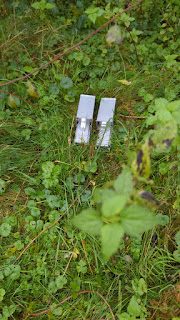Small Mammal Trapping
Last week, we did some small mammal trapping in the conservation area on the UEA campus. The traps were set the night before, and we checked them in the morning to find out what had been caught! Aside from lots of false triggers, we caught 9 wood mice. While we sadly didn't find any of the other species of small mammal present in the area, such as yellow-necked mice, bank and field voles, and common and pygmy shrews, the wood mice were still very cute! In this blog, I want to focus on the process of small mammal trapping, with a focus on ensuring the process is ethical and humane for our furry little friends.
Setting the traps
There are many different types of trap suitable for small mammal trapping. We used Longworth traps, but other potential traps include Sherman traps and Lifetraps. There are also less invasive methods of trapping, such as traps which record the footprints of animals that walk through. This removes the need for the animals to remain trapped for sustained periods of time, although identification of similar species may be hard, and other recordings such as measurement and weight cannot be taken.
When placing the traps, think like a mouse (or small mammal of your choice!) - they should be near areas of dense vegetation, and preferably near worn 'paths', where the target species are likely to be found. We placed the traps in pairs, with each pair about 5m away from each other. In cold conditions, it's a good idea to place insulating material such as straw around the trap to help keep anything caught inside warm during those long winter nights.
While the traps should be checked regularly anyway, when setting the traps you should provide enough food and resources for any animals that could potentially be caught to survive for a few days. This includes food, in the form of sunflower hearts for the mice and voles, casters (blow-fly larvae) for insectivorous shrews, and apple and carrot as a source of both food and water. We also used peanut butter to help lure animals into the traps, and some hay for insulation.
Two of our Longworth traps replaced in the field
Checking the traps
Provided sufficient food has been given, the traps should be checked at least twice a day, for example our traps were set in the night and checked early the morning after. The traps should be collected, and any triggered traps be carefully opened over a plastic bag to check if there is a small mammal inside. The mammal can be kept inside the bag while the necessary measurements are taken, including species identification, sex, length and weight. Samples of DNA may also be taken, for example from a mouth swab. The trapping process can be very stressful, so its important to release any captive animals as soon as possible. Allowing all the students on our course the chance to observe and practice handling the mice is very important educationally, but I do feel that passing each individual mice around the whole cohort caused the animals unnecessary stress.
Wood mice being examined after capture
Licensing and legislation
There are several important pieces of legislation in the UK which govern trapping and help safeguard against cruel practices, with the country also being covered by the Agreement on International Humane Trapping Standards, meaning only certified traps meeting certain welfare standards can be used. UK-specific legislation affecting small mammal trapping includes the Wildlife and Countryside Act 1981, the Conservation of Habitats and Species Regulations 2010 and the Wild Mammals (Protection) Act 1996. These laws both restrict what traps can be used, how the trapping process is carried out, and which species can legally be caught.
Although we weren't lucky enough to catch any, as we were trapping in an area where shrews can be found, we had to be covered by the licence GL01, which is required to trap shrews. As students, we were simply assisting in the trapping process and didn't require the licence ourselves. However, the licence is freely available online and you simply need to read the webpage covering some of the basics of humane trapping in order to become licenced to trap shrews. While this is more convenient for us, in my opinion this aspect of the licensing is problematic, meaning people need no prior experience of small mammal trapping whatsoever to be able to carry it out. This could easily lead to people, whether intentionally or not, breaking the terms of the licence and causing undue stress or even death to shrews or other small mammals.
Overall though, our time small mammal trapping was very interesting and informative, and I'm looking forward to using our newfound experience to carry out further trapping around the campus in the future, and updating you of what more cute critters we find!






Comments
Post a Comment